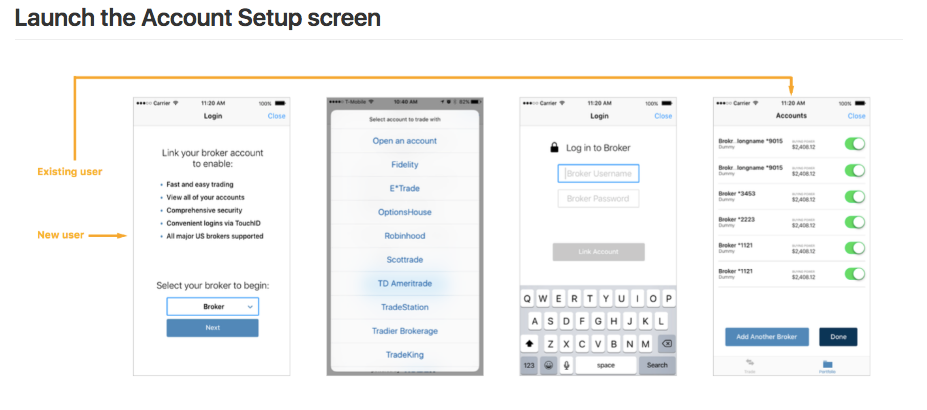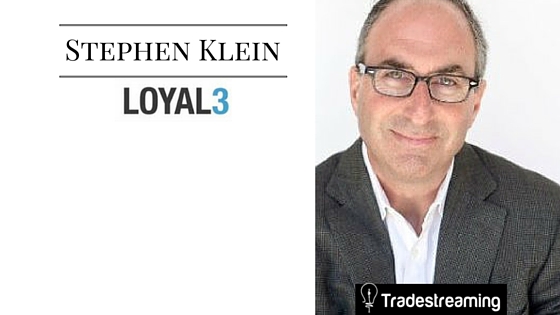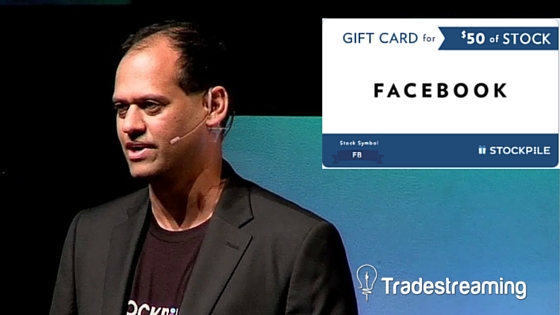Stephen Klein: LOYAL3 is turning IPO stock into a powerful, new brand engagement currency
LOYAL3 first burst onto the investing scene a couple of years ago with a simple premise: connecting people with the brands they love and providing an easy, cheap way to invest in them. The company provides a creative model that’s fee-free for investors. LOYAL3 has grown to include IPO and secondary stock offerings to its investors.
Stephen Klein, Chief Marketing Officer of LOYAL3, joins Tradestreaming for an interview about the company’s roots, how investing in stocks has changed and is changing, and how LOYAL3 is approaching product and distribution in 2016.
What is LOYAL3 and what was the genesis story (what was the inspiration the founders had to start the company)?

LOYAL3 is a financial technology company that is transforming the capital markets and concept of stock ownership. For small retail investors, our platform provides a new, easy and affordable way to invest in today’s top brands, and gain access to IPOs at the same time and price as large institutions and investors, with no fees to buy or sell stock. And for companies, we provide an innovative way to engage their affinity groups and allocate IPO and public stock to their employees, customers, partners and fans.
The idea for LOYAL3 stemmed from the thesis that ownership builds loyalty, and that enabling employees, customers, etc., to own shares of a company’s stock creates a net positive— for companies, individual investors, and the investing model as a whole. Ownership is a powerful branding and behavioral currency, and everyone should have the ability to invest in the companies they have an affinity for. In short, people care more about things they own than things they don’t, and this principle works for brands.
Has electronic trading and indexing changed the way investors think and behave with individual stocks?
Definitely. There’s been a fundamental shift in the way individuals invest. Investors are more engaged and want to have greater direct control over how they invest. There used to be a very limited set of investing options. But now, there’s a growing array of solutions that simplify the process, reduce or eliminate the fees charged by traditional brokerages, and cater toward each individual’s own personal investment needs.
Are you targeting experienced investors or investors newer to the markets?
We believe investing should be easy and affordable for everyone, so we designed our platform with newer and smaller investors in mind—ease of use, no fees to buy or sell stock, and the ability to purchase fractional shares of coveted stocks with high per-share prices. LOYAL3’s platform also attracts more experienced investors, but because we do not permit short selling or share lending and batch our trade orders, this limits the appeal to institutional investors or active traders.
What’s your IPO offering? How would investors invest in IPOs before using LOYAL3?
Historically, the ability to “invest in IPOs” had been limited to Wall Street and their core clients. It was nearly impossible for the general public to purchase shares before the first day of trading, unless they had a brokerage account and met “requirements” set by that firm, which were most always large sums of money in the investor’s accounts. Now, through the LOYAL3 platform, small retail investors are able to gain new access to IPOs, with the ability to purchase shares for as little as $100, at the same price and time as these institutions and large investors.
How are firms selling their stock via IPO using this service?
IPO issuers work with LOYAL3 because they see the value of offering IPO access to the people who really care about their company, employees, customers, partners, etc., and will bring us into the IPO process as a co-manager or part of the selling syndicate. They see this as a way to thank the people who made their success possible in the first place. So in essence they’re using IPO stock as a powerful and new brand engagement currency. We provide the same IPO services as a traditional investment bank, but also develop customized, branded digital content that enables B2B and B2C companies to engage these groups during their IPO in a more personalized way.
Is your success, in a way, a throwback to what investing used to/should be: affiliating with brands we love, etc.?
Investing has become cumbersome, expensive and overly institutionalized, and we wanted to change that. The idea of being able to own a piece of a brand you know or love makes sense and really resonates with people. It’s the difference between investing and speculating. It’s such a simple concept—if an individual already has an affinity for a company, why shouldn’t they be able to affordably invest in it? We would love to see a day where everyone is able to “own” a piece of the companies that matter most to them.
What’s next for your product service? What should investors be looking out for in 2016?
LOYAL3 regularly explores different types of opportunities that will facilitate new ways for people to invest and will be complementary to our existing offerings. We’re really excited by the possibility of stock loyalty rewards and custodial accounts, and we hope these are two things we’ll be able to offer in the future.
[podcast] Stockpile’s Avi Lele hopes to get investors excited about stocks again

In a world of roboadvisors, index funds, and algo trading, investors have learned to cut costs and simplify their investing. In some markets, over 90% of all trading is done by machines and we know markets are moved by large indices, not retail investors
It’s fair to say that we’ve lost that connection between an individual investor and the company behind a stock he or she owns. We may lack the connection but it’s also hard to come by the magic moment when an investor falls in love with a company and goes out to buy the stock to show his allegiance and affiliation.
Founder and CEO of Stockpile, Avi Lele joins us to talk about what it took to build a fractional share brokerage and how doing the small things right has positioned his company to just close a $15M investment round and launch in a big way.
Listen to the FULL episode
In this podcast, you’ll hear about the following:
- Stockpile’s retail product and distribution strategy
- How gift cards for stock works
- How Stockpile is combining physical and virtual distribution strategies
- How education plays a major role in investing discovery
- The challenges and opportunities in building a fractional brokerage
MORE RESOURCES
- Stockpile (website)
EVEN MORE RESOURCES
Brokers keep developing tools but can investors handle them?
Good piece by David Bogoslaw at Bloomberg Businessweek on all the new technology/trading development going on in the online brokerage space. It’s a  well-researched piece and does a great job of going through each online brokerage (including the smaller startups) and outline what they’ve been working on.
well-researched piece and does a great job of going through each online brokerage (including the smaller startups) and outline what they’ve been working on.
Some of the interesting functionality profiled in the article includes:
- shareable, backtestable stock screeners (TradeKing)
- expanded 3rd party research (RiskMetrics available at Fidelity, Seeking Alpha at E*Trade, Ned Davis at Schwab)
- Exceptional volume scanners (LiveAction at tradeMONSTER polls for unusual activity in the options market)
- more complicated buy/sell triggers (a few brokers)
- social media integration (most of them)
The Bloomberg Businessweek article ends with
With individual investors still spooked by the market meltdown of 2008-09 and by the sudden plunge in major indexes on May 6, the advanced tools that online brokers are providing could be a carrot that draws more people back to stocks—and gets them back in the habit of trading online.
Online brokerages misguided
I’m not so sure about this. The online brokerages continue to develop tools and underinvest in education. It makes sense — frequent traders are their bread and butter and in a commoditized space of trading, tools are one way (services are another) that help to differentiate.
Still, the average investor will never use these advancement and even if he/she could figure out how to use them, he still can’t answer why. Automated professional-grade advice is what these platforms should be advancing if they want to really capitalize accounts leaving traditional brokerages.
Source: Online Brokers Upgrade Retail Investor Tools (Bloomberg Businessweek)
photo courtesy of D’Arcy Norman
Will Merrill Lynch’s new online brokerage offering make a difference?
There’s been a lot of speculation about what or what not Merrill Lynch (now owned by Bank of United States of America) intends to do with its re-launch of Edge, Merrill’s online brokerage offering. Here’s a quick summary of what was punted around post-announcement:
- MorganStanley: We do not view Bank of America/Merrill Lynch’s new online brokerage product, Merrill Edge, as a serious competitor near to medium-term to Schwab and TD Ameritrade. Bank of America and Wells Fargo/Wachovia have had online brokerage products for some time and they haven’t impacted TD Ameritrade and Schwab’s ability to grow assets – clients choose to use one product over another and don’t easily switch. — Analyst, Celeste Mellet-Brown
- FBR Capital Markets: Bank of America will need to invest hundreds of millions in technology, customer support, and branding to truly compete for new customer assets. — Analyst, Matt Snowling
- Raymond James: It’s “highly unlikely” that Merrill Edge will cause a significant number of existing clients to leave Schwab, TD Ameritrade or E*Trade. We believe this is simply a re-branding of Bank of America’s existing online brokerage .– Analyst, Patrick O’Shaughnessy
- RIABiz: Such access could take the form of a team of advisors who handle inquiries up to some form of a hand-off plan where customers being handled by call centers could get referred to a full-service broker as their assets grow and their needs for advice become more sophisticated. In this hand-off endeavor, Merrill Lynch could have – in one respect – an edge over Fidelity, TD and Schwab, which have been successfully handing off billion of dollars of assets from their branches to RIAs for several years.
- Registered Rep: The idea is to convince current clients to give them the “play” money they have parked at the discounters, which can amount to substantial sums, and to capture the hearts and minds of young people who have yet to amass their wealth. We’re talking serious dollars here. At stake is a coming intergenerational transfer of wealth—the evolving wealth of today’s 87 million-strong, 20-something “millennial” population, born between 1979 and 1999. This wealth is projected to grow from $172 billion today to a staggering $13.4 trillion in investable assets (liabilities reaching a shocking $16.2 trillion) by 2030, according to internal Merrill research.
My Take
All of the reasons that Merrill Edge shouldn’t work (technology and service investments, channel conflict with Merrill’s financial advisors, incumbent leadership) are valid. Merrill’s 15,000 member strong advisory unit is/was a driving force for the firm and many of them view this launch as a threat to their core businesses.
But here’s the thing: I’ve written repeatedly that wealthy and soon-to-be-wealthy investors employ a combination of full-service and do-it-yourself investment tools. In fact, many of the brokerages are courting these types of investors with automated, professional-grade services, like E*Trade’s Online Advisor. As the future unfurls, these types of investors will continue to use tools and services that satiate the comfort of control and the need for professional advice. Merrill Edge plays right into this.
This isn’t about getting a $25k minimum account and praying the account holder brings more. It’s a foothold, but it’s also a way to hold onto wealthy clients with a lot more money under management as they oscillate moving their funds in into and out of semi self-directed tools and professional money managers. Edge gives that money one home.
Additional Resources
- BofA Seeks ‘Edge’ With Merrill Rivaling Online Firms (Bloomberg BusinessWeek)
- Bank of America Merrill Lynch Rolls Out Merrill Edge Discount Trading (Investment Advisor)
—> Like what you see? Hey! Don’t forget to subscribe to the free Tradestreaming newsletter for updates, tips, and special offers.
Inching towards an investing app store
Service and product providers in the financial field have always lamented how hard it was to reach investors.
Sure, we could market to the investing public in a large, splashy way but it would be so awesome if we could just do a deal with the online brokers and offer our services through an investment account login…
I know this sentiment well. When I was running business development at Seeking Alpha a few years back, it was so clear that the best/easiest/cheapest way to reach investors with our content was directly through the likes of E*Trade ($ETFC), Schwab ($SCHW), and TDAmeritrade ($AMTD).
This hasn’t been completely lost on the incumbent online brokers (but boy, do they move slowly!). I’ve riffed previously on how everything is moving towards the creation of investment app stores. Much like Apple’s famed AppStore, 3rd party service providers would be able to develop their services and products for delivery through the brokerage platform. TDAmeritrade has a short, but growing list of providers who are currently doing this here.
The investment app store concept is huge and extremely valuable for everyone in the value chain:
- Investors: Online brokerage clients no longer have to wait for the walled-garden brokers to develop their own tools and services. Brokerages are notoriously slow in rolling out new functionality or they typically acquire it (a-la TDAmeritrade’s purchase of ThinkorSwim).
- Brokers: No need to swell the ranks of the product dev teams. Now, they just have to manage the API and partnerships and they get a new revenue stream. Sweet.
- 3rd party solutions: Wham, investment newsletters, black box trading strategies, content aggregators and others have just been invited to the party. You can know actually technically reach the end user investor. Don’t expect the brokerages to promote you though 🙂
So, just like the tit-for-tat we’ve witnessed for years, we shouldn’t be surprised to see that E*Trade just announced the introduction of its API and partnerships with three external firms.
“Open API presents a world of opportunity to customers looking for a more customized investing experience and to software developers looking to create the next great investing app,” said Michael Curcio, President, E*TRADE Securities. “Our main objective is to facilitate innovation and ideas that empower customers — ultimately creating a richer investing experience.”
Source: E*Trade Bolsters Trading Innovation with Open Application Programming Interface (MarketWatch)
—> Like what you see? Hey! Don’t forget to subscribe to the free Tradestreaming newsletter for updates, tips, and special offers.
Photo credit: Jurvetson photostream











